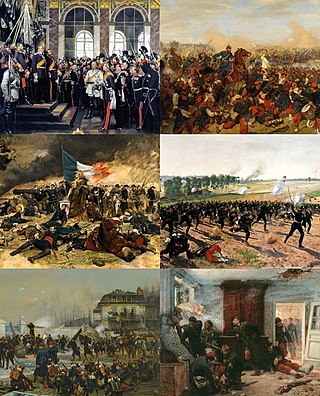
The Franco-Prussian War or Franco-German War, often referred to in France as the War of 1870, was a conflict between the Second French Empire and the North German Confederation led by the Kingdom of Prussia. Lasting from 19 July 1870 to 28 January 1871, the conflict was caused primarily by France's determination to reassert its dominant position in continental Europe, which appeared in question following the decisive Prussian victory over Austria in 1866. According to some historians, Prussian chancellor Otto von Bismarck deliberately provoked the French into declaring war on Prussia in order to induce four independent southern German states—Baden, Württemberg, Bavaria and Hesse-Darmstadt—to join the North German Confederation; other historians contend that Bismarck exploited the circumstances as they unfolded. All agree that Bismarck recognized the potential for new German alliances, given the situation as a whole.

The siege of Paris took place from 19 September 1870 to 28 January 1871 and ended in the capture of the city by forces of the various states of the North German Confederation, led by the Kingdom of Prussia. The siege was the culmination of the Franco-Prussian War, which saw the Second French Empire attempt to reassert its dominance over continental Europe by declaring war on the North German Confederation. The Prussian-dominated North German Confederation had recently emerged victorious in the Austro-Prussian War of 1866, which led to the questioning of France’s status as the dominant power of continental Europe. With a declaration of war by the French parliament on 16 July 1870, Imperial France soon faced a series of defeats at German hands over the following months, leading to the Battle of Sedan, which, on 2 September 1870, saw a decisive defeat of French forces and the capture of the French emperor, Napoleon III.

The siege of Strasbourg took place during the Franco-Prussian War, and resulted in the French surrender of the fortress on 28 September 1870.

The Army of the Vosges was a volunteer force placed under the command of Giuseppe Garibaldi, formed in order to ensure the defense of the road to Lyon from the Prussian Army during the Franco-Prussian war.
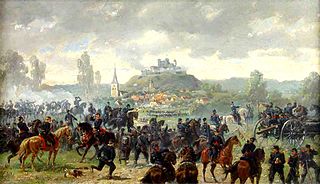
The siege of Lichtenberg was a battle of the Franco-Prussian War that took place on August 9–10, 1870 at Lichtenberg Castle between French and German troops. After a brief but fierce shelling a German force under the command of Generalmajor Hermann Freiherr von Hügel, part of the Württemberg Division and the Third Army forced the surrender of the French garrison of Lichtenberg under the command of Second Lieutenant Archer. In addition to Lichtenberg, in a single period in August 1870, the German army also defeated the French fortresses of La Petite-Pierre, Marsal and Vitry-le-François.

The siege of Phalsbourg was an early battle of the Franco-Prussian War that was fought between the French Empire against Germany at Phalsbourg near the Vosges beginning on 10 August 1870, and ending on 12 December of the same year.
The siege of Marsal was a battle of the Franco-Prussian War on August 13 to 14 between the French Empire and the combined German forces of Prussia and Bavaria in Marsal Under the command of Lieutenant General Jakob von Hartmann, after replacing the Prussian 4th Cavalry Division, II Corps of the Kingdom of Bavaria forced the surrender of the French Empire's defenses, after a brief resistance by the French troops stationed at the fortress. Marsal fell to the German army in the same period as the French fortresses of Lichtenberg, La Petite-Pierre and Vitry. With the quick victory of the Bavarian army at Marsal, the road from Dieuze to Nancy was open to the Germans. In addition, the siege also brought the Germans a lot of raw materials for the war, as well as hundreds of prisoners.

The siege of Montmédy was a battle of the Franco-Prussian War at the small commune of Montmédy, in the Meuse, it was besieged by the army of the German coalition. Defended by the 57th Line Infantry Regiment, the Garde Mobile and elements of other units, it surrendered on December 14, 1870.
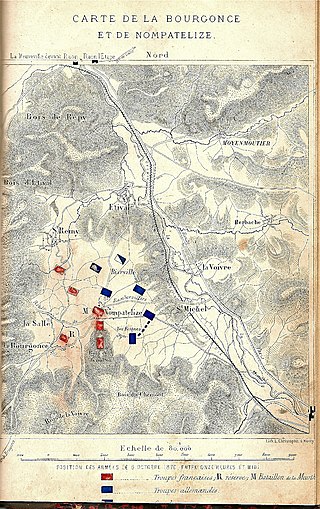
The Battle of Nompatelize, also known as the Battle of Etival, was a battle of the Franco-Prussian War on October 6, 1870, between Etival and Nompatelize in the province of Vosges from Strasbourg 64 km southwest. This battle marked the first major crackdown of franc-tireur operations in the Vosges region by the XIV Corps of the Prussians by Minister August von Werder in early October 1870. In matches fiercely this, A force of the Army of Rhône of the French Republic under the command of General Louis-François Dupré, who predominated to markedly document in terms of troop numbers, and attacked 6 infantry battalions of the Grand Duchy of Baden under the command of General Alfred von Degenfeld which were part of the XIV Corps, but were defeated. Compared to the casualties of the German military, the losses of the French side in this battle were much greater. After seven hours of fighting, the French were forced to flee in turmoil to Bruyeres and the Rambervillers. The Battle of Etival contributed to General Werder wiping out the French from Alsace.
The siege of Neu-Breisach was a battle of encirclement in the Franco-Prussian War, which took place from 13 October until 10 November 1870 in France. A few days after the surrender at Fort Mortier of Neu-Breisach, with a divisional reserve, German General Hermann von Schmeling forced the fortress of Neu-Breisach which surrendered, and won many spoils from the French army here. The siege demonstrated the high efficiency of the Baden batteries. With the surrender of Neu-Breisach, the Imperial German Army captured the last of the fortifications at Alsace, except for the Belfort and of Bitche. After this victory, Von Schmeling moved his cannons southwest to carry out the Siege of Belfort.
The Siege of La Fère took place during the Franco-Prussian War from 15 November until 26 November 1870, at the fortress of La Fère in France. French troops stationed at La Fère under the command of Captain Jacques Ferdinand Planche resisted the siege from the Imperial German Army, but surrendered the fort after eleven days on 26 November 1870, which resulted in a German victory. During the siege, the German army captured thousands of prisoners, most of whom were Garde Mobile soldiers, and took control of many French weapons. The German shelling of La Fère took place over the course of two days and severely damaged the town. After the Germans captured La Fère, they used cannons to arm the stronghold of Amiens.
The siege of Sélestat was a siege, extending from 20 to 24 October 1870, of the French Alsatian fortress of Sélestat, during the Franco-Prussian War. After artillery bombardment by the Germans, the siege ended when the French army surrendered, mainly because the French garrison was demoralized. The Germans suffered only minor losses, while this victory brought them many spoils.

The Battle of Châteaudun was a battle in northwestern France during the Franco-Prussian War, which took place on October 18, 1870. In this battle, the Imperial German Army led by General Friedrich Wilhelm Ludwig von Wittich attacked the city of Châteaudun and captured the city. During the nine-hour battle the attackers defeated forces that included Francs-tireurs led by Ernest de Lipowski who was of Polish origin. Although it ended in defeat, the resistance of the French army at Châteaudun is recorded by one document as legendary. The fighting at Châteaudun was immortalized by a painting by Philippoteaux.
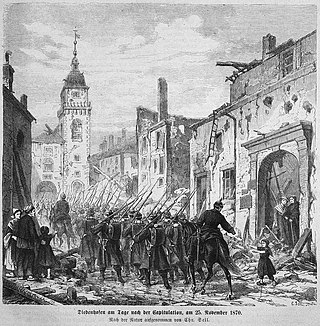
The siege of Thionville was a battle of the Franco-Prussian War which occurred in Thionville of the Moselle from November 13 to November 24, 1870. The small French garrison repulsed an attempted attack on August 14. It was subjected to a blockade and then besieged from November 13. After the capitulation of Metz, on October 28, 1870, the Prussians move part of their powerful artillery to Thionville. Bombed from November 22, the square surrendered on November 24. The capture of Thionville and that of Montmédy a month later gave the Germans control of the railroad to the Picardy front.
The siege of Mézières was a siege battle during the Franco-Prussian War, it took place from November 17, 1870 until January 2, 1871, in Mézières-en-Gâtinais which is located on the banks right of the river Meuse in France. After suffering from a German artillery strike, the French army at Mézières under the command of Colonel Vernet, surrendered to Germany under the command of Major General Wilhelm von Woyna on January 2, 1871. Although lasting just over a day, German artillery bombardment caused French defenders and civilians in Mézières heavy losses. With the victory, the Germans captured many French officers and soldiers, with many cannons and supplies from the enemy's reserves. Not only that, the victory at the Siege of Mézières made the German army have complete dominance of the railway line in the north extending from Metz and Mézières to Paris, capital of France.

The Battle of Varize was a battle in the Franco-Prussian War, that happened on November 29, 1870, in Varize, on the river Conie. In this battle, the First Bavarian Corps under the command of Lieutenant General Infantry Ludwig von der Tann attacked a guerrilla army franc-tireurs of the French Republic under the command of Colonel Ernest de Lipowski, and made them scatter. Despite this, the defense at Varize enabled General Antoine Chanzy, commander of the French Army of Loire, to establish a defensive formation against the Prussian army under the direction of Friedrich Franz II, Grand Duke of Mecklenburg-Schwerin. With their victory at the Battle of Varize, Bavarian forces captured a number of well-equipped French guerrillas.
The Battle of Buchy was a battle fought during the Franco-Prussian War, on 4 December 1870, at Buchy, Seine-Maritime, France. During the battle, the VIII Corps of the Prussian Army, under the command of General of the Infantry August Karl von Goeben, suddenly attacked and defeated a French force under the command of General de Brigade Guillaume Briand. The French suffered heavy losses. After their victory at Buchy, German troops captured Rouen.

The siege of Peronne was a battle during the Franco-Prussian War, from December 26, 1870 until January 9, 1871, in Péronne, Somme of France. The German siege force, under the command of Lieutenant Generals August von Goeben and Albert von Barnekow, forced the French army at Péronne- which could not be rescued and had to surrender after more than a week under the bombardment of the Prussian army. With the victory, the armies of Albert von Barnekow captured a defending force of thousands of French soldiers in Peronne, and obtained a large number of cannons and war materials to the Prussians hands. In general, the advantage of the artillery of the Prussians as well as the dynamism of German officers is credited with leading to German victories in the sieges of French fortresses, and the success at the Siege of Péronne solidified German control over the river Somme.

The siege of Rocroi was a battle of the Franco-Prussian War, it was held in January 4 to the 6th, 1871 at Rocroi which was a bastion of France located to the west of Sedan. After an artillery fire by the Prussian army, the officer commanding the French troops at Rocroi was forced to surrender the Division Militia under General Schuler and Sendan and Wilhelm von Woyna. With the success of the Siege of Rocroi, the military spectrum was obtained on their hands were hundreds of prisoners along with many stocks, costumes and contemporary heavyweight artillery of the French. During this siege, the town of Rocroi was heavily destroyed. The fall of Rocroi marked one of the German army's consecutive victories in the war.
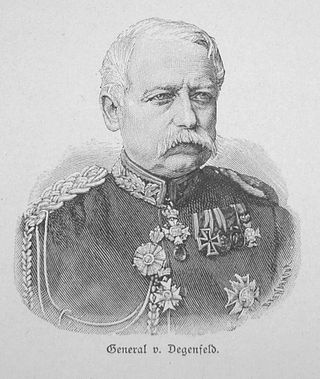
Alfred Emil Ludwig Philipp Freiherr von Degenfeld was a Badensian-Prussian general and a member of the Reichstag.













